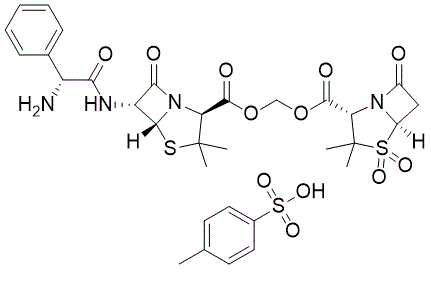Sultamicillin Tosylate, the tosylate salt form of Sultamicillin which is a double ester of sulbactam and ampicillin. Sultamicillin (formerly known as CP-49952 and VD 1827) is an orally available, mutual prodrug form of ampicillin and sulbactam. As an antibiotic combination (co-drug or mutual prodrug) of ampicillin/sulbactam, it contains esterified ampicillin and sulbactam and is marketed under a number of trade names, e. g. Unasyn from Pfizer. Ampicillin is a semi-synthetic orally active broad spectrum antibiotic which is linked via a methylene group with a beta-lactamase inhibitor. Sultamicillin is chemically oxymethyl penicillinate sulfone ester of ampicillin. After absorption, sultamicillin releases ampicillin and sulbactam into the system, so all the antibacterial efficacy of sultamicillin is due to ampicillin and sulbactam. Ampicillin exerts antibacterial activity against sensitive organisms by inhibiting biosynthesis of cell wall mucopeptide where as sulbactam irreversibly inhibits most important beta-lactamases that occur in resistant strains.
Physicochemical Properties
| Molecular Formula | C32H38N4O12S3 |
| Molecular Weight | 766.86 |
| Exact Mass | 766.164 |
| Elemental Analysis | C, 47.87; H, 5.27; N, 6.98; O, 27.90; S, 11.98 |
| CAS # | 83105-70-8 |
| Related CAS # | 76203-99-1 (HCl);76497-13-7 (free);83105-70-8; |
| PubChem CID | 444021 |
| Appearance | White to off-white solid powder |
| Boiling Point | 907.7ºC at 760 mmHg |
| Flash Point | 502.8ºC |
| LogP | 3.781 |
| Hydrogen Bond Donor Count | 3 |
| Hydrogen Bond Acceptor Count | 14 |
| Rotatable Bond Count | 10 |
| Heavy Atom Count | 51 |
| Complexity | 1450 |
| Defined Atom Stereocenter Count | 6 |
| SMILES | S1([C@]2([H])C([H])([H])C(N2[C@@]([H])(C(=O)OC([H])([H])OC([C@@]2([H])C(C([H])([H])[H])(C([H])([H])[H])S[C@]3([H])[C@@]([H])(C(N32)=O)N([H])C([C@@]([H])(C2C([H])=C([H])C([H])=C([H])C=2[H])N([H])[H])=O)=O)C1(C([H])([H])[H])C([H])([H])[H])=O)(=O)=O.S(C1C([H])=C([H])C(C([H])([H])[H])=C([H])C=1[H])(=O)(=O)O[H] |
| InChi Key | KNVDAMRBJYZXRW-ZAKZIJIGSA-N |
| InChi Code | InChI=1S/C25H30N4O9S2.C7H8O3S/c1-24(2)17(29-20(32)16(21(29)39-24)27-19(31)15(26)12-8-6-5-7-9-12)22(33)37-11-38-23(34)18-25(3,4)40(35,36)14-10-13(30)28(14)18;1-6-2-4-7(5-3-6)11(8,9)10/h5-9,14-18,21H,10-11,26H2,1-4H3,(H,27,31);2-5H,1H3,(H,8,9,10)/t14-,15-,16-,17+,18+,21-;/m1./s1 |
| Chemical Name | [(2S,5R)-3,3-dimethyl-4,4,7-trioxo-4lambda6-thia-1-azabicyclo[3.2.0]heptane-2-carbonyl]oxymethyl (2S,5R,6R)-6-[[(2R)-2-amino-2-phenylacetyl]amino]-3,3-dimethyl-7-oxo-4-thia-1-azabicyclo[3.2.0]heptane-2-carboxylate;4-methylbenzenesulfonic acid |
| Synonyms | Sultamicillin tosilate; Sultamicillin tosylate hydrate; Sultamicillin; CP-49,952; CP 49,952; CP49,952; CP-49952; CP 49952; CP49952. VD 1827; Bacimex; p-Toluenesulfonate Sbtpc; Unacid PD oral; acim orale. |
| HS Tariff Code | 2934.99.9001 |
| Storage |
Powder-20°C 3 years 4°C 2 years In solvent -80°C 6 months -20°C 1 month Note: Please store this product in a sealed and protected environment (e.g. under nitrogen), avoid exposure to moisture and light. |
| Shipping Condition | Room temperature (This product is stable at ambient temperature for a few days during ordinary shipping and time spent in Customs) |
Biological Activity
| Targets | β-lactam | ||
| ln Vitro | Sultamicillin tosylate shows antibacterial activity against MRSA with a MIC value of 25 μg/mL[4]. | ||
| ln Vivo |
Sultamicillin tosylate is hydrolyzed to yield Sulbactam (HY-B0334) and Ampicillin (HY-B0522) after oral absorption[2]. When combined with an immunosuppressive medication (such as mycophenolate mofetil (HY-B0199) and methylprednisolone (HY-B0260), streptomycin (oral gavage, every 12 hours) significantly increases the survival of experimental polymicrobial sepsis in mice and improves bacterial clearance[3]. |
||
| Animal Protocol |
|
||
| References |
[1]. Sultamicillin. A review of its antibacterial activity, pharmacokinetic properties and therapeutic use. Drugs. 1989 Apr;37(4):491-522. [2]. Pharmacokinetics of sultamicillin in mice, rats, and dogs. Antimicrob Agents Chemother. 1984 May;25(5):599-602. [3]. Combined immunosuppressive and antibiotic therapy improves bacterial clearance and survival of polymicrobial septic peritonitis. Shock. 2010 Feb;33(2):155-61. [4]. Indole-based derivatives as potential antibacterial activity against methicillin-resistance Staphylococcus aureus (MRSA). Eur J Med Chem. 2020 May 15;194:112245. |
Solubility Data
| Solubility (In Vitro) |
DMSO : 100~125 mg/mL ( 130.4~163.00 mM ) Ethanol : ~100 mg/mL Water : ~9 mg/mL |
| Solubility (In Vivo) |
Solubility in Formulation 1: ≥ 2.08 mg/mL (2.71 mM) (saturation unknown) in 10% DMSO + 40% PEG300 + 5% Tween80 + 45% Saline (add these co-solvents sequentially from left to right, and one by one), clear solution. For example, if 1 mL of working solution is to be prepared, you can add 100 μL of 20.8 mg/mL clear DMSO stock solution to 400 μL PEG300 and mix evenly; then add 50 μL Tween-80 to the above solution and mix evenly; then add 450 μL normal saline to adjust the volume to 1 mL. Preparation of saline: Dissolve 0.9 g of sodium chloride in 100 mL ddH₂ O to obtain a clear solution. Solubility in Formulation 2: ≥ 2.08 mg/mL (2.71 mM) (saturation unknown) in 10% DMSO + 90% (20% SBE-β-CD in Saline) (add these co-solvents sequentially from left to right, and one by one), clear solution. For example, if 1 mL of working solution is to be prepared, you can add 100 μL of 20.8 mg/mL clear DMSO stock solution to 900 μL of 20% SBE-β-CD physiological saline solution and mix evenly. Preparation of 20% SBE-β-CD in Saline (4°C,1 week): Dissolve 2 g SBE-β-CD in 10 mL saline to obtain a clear solution. Solubility in Formulation 3: ≥ 2.08 mg/mL (2.71 mM) (saturation unknown) in 10% DMSO + 90% Corn Oil (add these co-solvents sequentially from left to right, and one by one), clear solution. For example, if 1 mL of working solution is to be prepared, you can add 100 μL of 20.8 mg/mL clear DMSO stock solution to 900 μL of corn oil and mix evenly. Solubility in Formulation 4: 10% DMSO+40% PEG300+5% Tween-80+45% Saline: ≥ 2.08 mg/mL (2.71 mM) (Please use freshly prepared in vivo formulations for optimal results.) |
| Preparing Stock Solutions | 1 mg | 5 mg | 10 mg | |
| 1 mM | 1.3040 mL | 6.5201 mL | 13.0402 mL | |
| 5 mM | 0.2608 mL | 1.3040 mL | 2.6080 mL | |
| 10 mM | 0.1304 mL | 0.6520 mL | 1.3040 mL |
